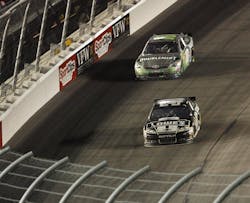Jimmie Johnson and No. 48 out-dueled a charging Denny Hamlin and Tony Stewart for the checkered flag at Darlington Raceway’s grueling Bojangles’ Southern 500 Saturday night May 12, for Hendrick Motorsports’ 200th NASCAR Sprint Cup Series win. As in the night race at Richmond International Raceway two weeks before, the oxygen sensors in Johnson’s Chevrolet monitored the changing nighttime oxygen level and air density, and sent virtually continuous signals to the vehicle computer so it could adjust fuel delivery for optimum performance in the changing race conditions.
Oxygen sensors did the same in the top-ten Chevrolets of Stewart-Haas Racing’s Stewart, Kasey Kahne driving for Hendrick Motorsports, and the Joe Gibbs Racing Toyotas of Hamlin, Kyle Busch and Joey Logano. All these drivers ran with Bosch spark plugs, fuel injectors, fuel pumps, coils, alternators and starters, as well as Bosch oxygen sensors.
In this year’s previous night race at Richmond, Kyle Busch, driving a Toyota for Joe Gibbs Racing, held off Tony Stewart and Dale Earnhardt Jr. for the win, Top ten Chevrolets of Stewart, Earnhardt, Kasey Kahne and Jimmie Johnson, along with the Penske Dodge of Brad Keselowski and fellow Toyota driver Denny Hamlin also ran with Bosch spark plugs, fuel injectors, fuel pumps, coils, alternators and starters, as well as Bosch oxygen sensors.
Actually, every car in these races depended on Bosch oxygen sensors to keep their engines running at peak efficiency throughout the nighttime changes in the races.
“NASCAR race cars go through many different operating conditions, especially in day-to-night racing as the track cools and the air becomes denser as evening progresses over the course of the race. Oxygen sensors are an important component of the fuel injection system, and the wide-band sensors send varying, virtually continuous signals from ‘rich’ to ‘lean’ and anywhere in between, allowing the management computer to adjust the air/fuel ratio for best performance,” said Wolfgang Hustedt, Bosch Motorsports Manager, North America. “The wide-band O2 sensors respond to changes in the air/fuel mixture in less than 100 milliseconds (a millisecond is 1/1000 of a second), and reach operating temperature of 1400°F within 20 seconds or less, offering virtually immediate fuel management.”
“Bosch Oxygen Sensors are an exclusive NASCAR Performance product, and all NASCAR Sprint Cup Series fuel injected engines utilize Bosch oxygen sensors. Fuel injection is a logical progression for NASCAR, and an onboard computer controls fuel injectors in all NASCAR Sprint Cup SeriesTM race car engines, using input from two Bosch wide-band oxygen sensors in the exhaust to determine the right amount of fuel to add to the airflow just as it’s entering the cylinders. This change to fuel injection will give NASCAR teams enhanced control over their vehicle performance, especially under changing race conditions, and the oxygen sensors are essential for maximum but flexible performance at each race.”
Fuel injection pioneer Bosch introduced mass-produced electronic fuel injection and the first automotive oxygen sensors more than 35 years ago, and steadily upgrades system technology as it supplies automobile manufacturers, the aftermarket, and the racing community around the world with the most advanced systems.



